Reviewing any sort of gaming peripheral is best done in the real world, with real world gaming tests. To test the Roccat Ryos TKL Pro it was put through its paces over the course of a week and used in a number of different games and for general purpose typing and office usage. Throughout, it was evaluated on its ability as a gaming keyboard, how it is to type on and how comfortable it is as well.
As for the Ryos TKL Pro's general gaming ability, it is pretty typical for one with Cherry MX Brown switches. They are light and responsive, but thanks to the tactile actuation point, you do not necessarily need to depress a key all the way down to know it has been activated. This feels like it translates into a slight speed advantage over other types of keys, but that is likely going to be dependent on your gaming style as much as anything else.
For those that have never used a mechanical board, one like this feels far more precise than a membrane keyboard and is certainly faster at responding to your touch. It will also last longer, as Cherry MX keys are rated at 50 million plus keystrokes.
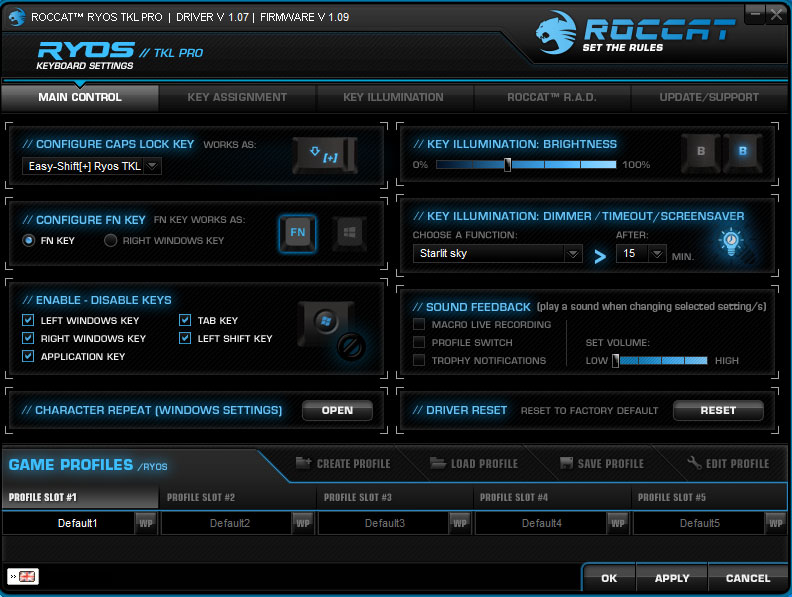
Back end software for the keyboard is versatile and easy to navigate as most Roccat software is
In terms of the smaller form factor and layout, I found the Ryos lovely to game on and it was great to have the wrist rest there for when the action was not quite so intense. Funnily enough, despite the fact that certain keys are not present on this board, such as a capslock and the numpad, there were a couple of games that needed those specific keys which I played during testing: Bloodbowl and Kerbal Space Program. While the latter I was able to fix by doing some key remaps to give me the ability to make my RCS thrusts make minor translations, the former was not so easy. Just bear that in mind if considering this board.
When it comes to typing, I really enjoyed my time with the Ryos TKL. Apart from possibly the Steelseries M800's shortened keys, Cherry MX Brown switches are my favourite to type on. They are light and fast so do not wear out your fingers on a long day of typing, but they also allow you to press (and release) keys that bit quicker because of that tactile feel that is not available in MX Red and Black switches. They are very much like blues, with less of a clicky noise so are much less likely to annoy anyone in the house with you.
For some context, my average typing speed on most keyboards is around 110 words per minute. With the Roccat Ryos TKL Pro I was averaging closer to 120 WPM. It is not a huge difference, but for those that type all day, it can make quite a difference to how fast your work is completed.
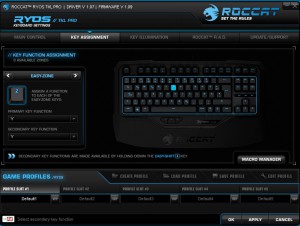
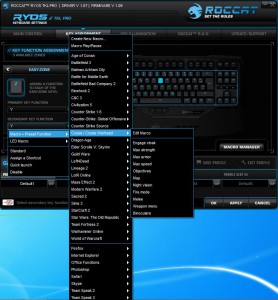
Key remapping options for standard and Easy-Shift are deep and simple thanks to an extensive drop down menu system
Although I liked the extensive collection of added functions that this keyboard has, their placement was a bit odd for me. I did not like that FN key and the media keys were on opposite ends of the board, making it so that only those with extra large hands can adjust the volume with one hand. If if I am doing so with my keyboard, I want to be able to leave one hand on the mouse or WASD keys so I have some functionality mid-game. If I had time to adjust the volume properly, I would not be doing so with the function keys.
Fortunately then this issue can be fixed by remapping some of the keys in the T-section to have a secondary media function. Oddly though, not every key on the board can be remapped to everything else, as there is no option for media keys in the drop down for the main letters and numbers. So you are restricted in this respect to those T keys.
However, I did like the placement of the T1-3 keys. While seldom used, they are in an easy to reach spot that does not feel tacked on like the Macro keys on some boards are. They are unobtrusive and easy to reach and though they are not as responsive as I would like them to be, they serve the player well.
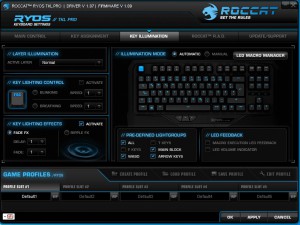
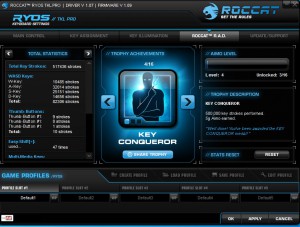
Lighting is limited to blue, but you can make several changes to how it displays. Stat tracking is also possible.
Lighting options in the back end are quite nice, with the ability to use different ripple and wave effects, or have them display a certain pattern when a macro is engaged. I particularly liked how the LEDs on the board light up along the number keys when you raise or lower the volume, indicating how loud it is.
It is worth noting that this is an extremely stable board. While it is very rare for any keyboard to move around during operation, there has not even been a single nudge from the Ryos. Thanks to its rubber coating on the underside of the extension feet and the large rubber foot on the wrist rest, this board does not move at all and felt solid throughout all testing.
Although not something I made particular use of, I liked the cable routing too, which was a nice touch to add to the board without overcomplicating things. The channels on the underside let people send the cable just where they want.
 KitGuru KitGuru.net – Tech News | Hardware News | Hardware Reviews | IOS | Mobile | Gaming | Graphics Cards
KitGuru KitGuru.net – Tech News | Hardware News | Hardware Reviews | IOS | Mobile | Gaming | Graphics Cards


